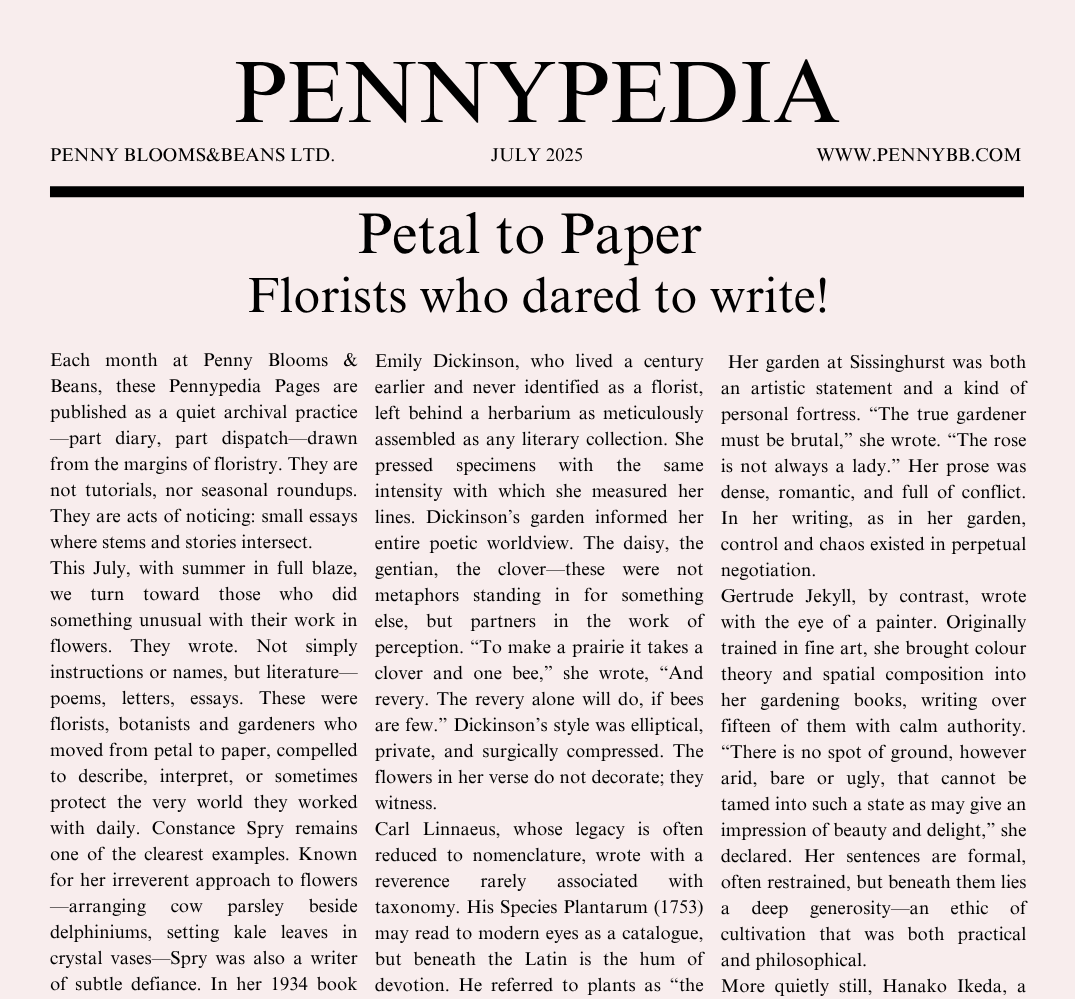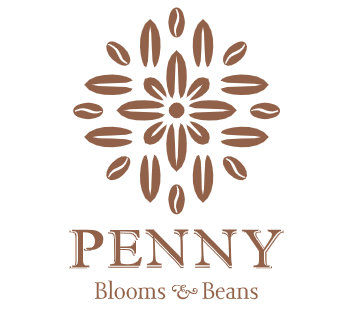
01 Jul Petal to Paper: Florists Who Dared to Write
 Each month at Penny Blooms & Beans, these Pennypedia Pages are published as a quiet archival practice—part diary, part dispatch—drawn from the margins of floristry. They are not tutorials, nor seasonal roundups. They are acts of noticing: small essays where stems and stories intersect.
Each month at Penny Blooms & Beans, these Pennypedia Pages are published as a quiet archival practice—part diary, part dispatch—drawn from the margins of floristry. They are not tutorials, nor seasonal roundups. They are acts of noticing: small essays where stems and stories intersect.
This July, with summer in full blaze, we turn toward those who did something unusual with their work in flowers. They wrote. Not simply instructions or names, but literature—poems, letters, essays. These were florists, botanists and gardeners who moved from petal to paper, compelled to describe, interpret, or sometimes protect the very world they worked with daily.
Constance Spry remains one of the clearest examples. Known for her irreverent approach to flowers—arranging cow parsley beside delphiniums, setting kale leaves in crystal vases—Spry was also a writer of subtle defiance. In her 1934 book Flower Decoration, she made a case not only for beauty, but for beauty’s accessibility. She encouraged resourcefulness during wartime, turning cabbage leaves and tins into moments of grace. Her tone was gently radical, stripped of pretence. “Do not be afraid to cut and come again,” she wrote. “There is beauty in impermanence.” Her prose was as unorthodox as her arrangements—clean, plainspoken, and quietly political.
Emily Dickinson, who lived a century earlier and never identified as a florist, left behind a herbarium as meticulously assembled as any literary collection. She pressed specimens with the same intensity with which she measured her lines. Dickinson’s garden informed her entire poetic worldview. The daisy, the gentian, the clover—these were not metaphors standing in for something else, but partners in the work of perception. “To make a prairie it takes a clover and one bee,” she wrote, “And revery. The revery alone will do, if bees are few.” Dickinson’s style was elliptical, private, and surgically compressed. The flowers in her verse do not decorate; they witness.
Carl Linnaeus, whose legacy is often reduced to nomenclature, wrote with a reverence rarely associated with taxonomy. His Species Plantarum (1753) may read to modern eyes as a catalogue, but beneath the Latin is the hum of devotion. He referred to plants as “the children of the sun,” and viewed each classification as a small act of awe. “I saw God’s infinite wisdom in a leaf,” he wrote. Though clinical in structure, his language was devotional in tone—his categories carried the precision of science, but also the rhythm of prayer.
A century later, Vita Sackville-West blended horticulture with literature more overtly. A novelist and garden columnist for The Observer, she was never entirely at ease in either world—too aristocratic for one, too unruly for the other. Her garden at Sissinghurst was both an artistic statement and a kind of personal fortress. “The true gardener must be brutal,” she wrote. “The rose is not always a lady.” Her prose was dense, romantic, and full of conflict. In her writing, as in her garden, control and chaos existed in perpetual negotiation.
Gertrude Jekyll, by contrast, wrote with the eye of a painter. Originally trained in fine art, she brought colour theory and spatial composition into her gardening books, writing over fifteen of them with calm authority. “There is no spot of ground, however arid, bare or ugly, that cannot be tamed into such a state as may give an impression of beauty and delight,” she declared. Her sentences are formal, often restrained, but beneath them lies a deep generosity—an ethic of cultivation that was both practical and philosophical.
More quietly still, Hanako Ikeda, a Japanese ikebana master writing after the Second World War, produced a small series of essays now largely forgotten. Her reflections were meditations on space, grief, and order. “In silence,” she wrote, “the branch tells what cannot be spoken. The flower bows not to beauty, but to time.” Her writing is pared back to its essentials: declarative, rhythmic, and shaped with the same intentionality as her arrangements.
What binds these figures is not merely that they worked with flowers and words, but that they believed one could lead to the other. They remind us that floristry—so often treated as a non-verbal art—has always had a language. That the cut stem, the chosen vessel, the gesture of placement, can all be translated into prose, if one pays close enough attention.
At Penny Blooms & Beans, these Pennypedia Pages are offered as a continuation of that belief: that flowers deserve writers. That floristry has its own archive. That to arrange is also, sometimes, to record.
Next month, we may turn back to petals. But this July, we give the final word to those who placed them in ink.
